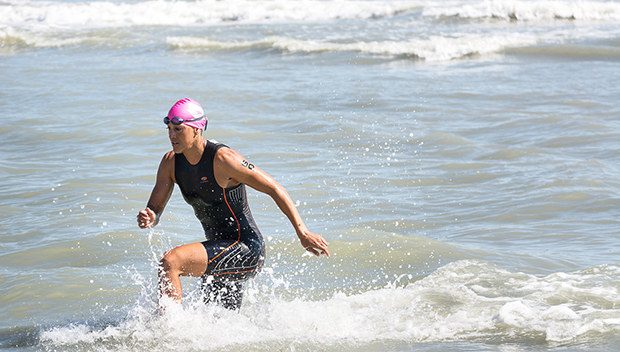
The bike-run brick has long been a staple of the multisport athlete's training regimen. Adapting your legs to both the rigors and the mechanics of running off the bike is an important part of successful racing. However, there's another essential "brick" that many triathletes are missing from their training repertoire—the swim-run.
More: How to Get Excited About Transition Runs
Granted, the swim-run brick is a little more logistically complicated than running off the bike. Since most triathletes train in a pool, usually indoors, running right out of the water is not as easy as simply jumping off the bike, throwing on some running shoes and taking off down the road (or on the treadmill). Many fitness clubs would most likely frown on soaking-wet swimmers running through their facilities dripping water on the floors, treadmills or track.
Outdoor pools make transitioning to the run easier, but are usually limited to summer season use only, unless you live somewhere warm year-round. The same goes for open-water swimming areas.
More: 3 Brick Workouts to Help You Run Faster, Longer
Nevertheless, there are several reasons why incorporating swim-run bricks into your training program is well worth the additional effort:
Long or challenging transition runs. Many races these days—especially those that feature ocean swims—require athletes to make long runs to transition after exiting the water. These transitions seem almost like endurance events in themselves. The Chicago Triathlon is notorious for its over quarter-mile run from the swim exit to transition. Ironman Wisconsin makes athletes run a long pathway and then up a winding route to the transition area at the top of a parking structure.
Training your body to run when it's already sputtering and gasping for air can help make those runs to transition less daunting and painful—and being able to run better out of the water can help shave time off your T1, as well.
More: 12 Tips for a Faster Transition
Quickly regain your land legs. Know that woozy feeling you have after stumbling out of the water while trying to focus and make your way to T1? In much the same way that transition runs help your body "learn" how to run quickly and efficiently off the bike, swim-run training helps your body learn to quickly adapt from the horizontal to the vertical—thus curtailing that wobbly feeling you might have coming right out of the water. It's also a good way to prepare for races that feature a two-lap swim where athletes are required to exit the water and run around markers on the beach before beginning the next lap.
More: Training for a T1 Transition
They add variety to your training. Swim-run bricks offer a break from the typical bike-run training. Rather than try to cram a swim-run brick into an already overcrowded training schedule, alternate them on a weekly or bi-weekly basis, substituting them for a standard transition run workout after you bike. Also, for triathletes who travel for work, they provide an effective way to get in a quality brick workout while on the road.
Now that you know why you should incorporate swim-run bricks into your training, it's time to learn how. As stated before, it may be more challenging to go into a run right out of the water. However, with a little bit of planning—and ingenuity—it can be done.


